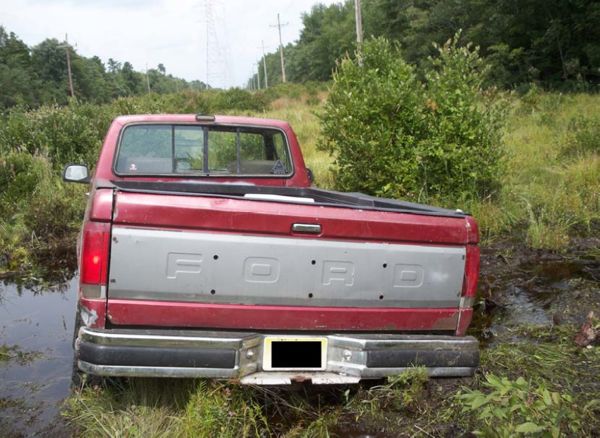Gov. Christie’s Post Sandy Hazard Mitigation Plan Pays Lip Service To Climate Change and Sea Level Rise
Plan Developed By Private Consultant Behind Closed Doors
Public Comments Will Be Ignored
With this increase in frequency of precipitation, New Jersey may experience more flooding events. More intense, frequent flooding could lead to significant habitat loss for wildlife. Salt marshes and estuaries that serve as critical feeding grounds for birds and waterfowl, and as nursery habitats for commercial fish, could be lost (State of New Jersey 2010). Future climate change may also lead to sea level rise which could lead to more frequent and extensive flooding. See Section 5.2 (Coastal Erosion) for detailed information regarding sea level rise (NJDEP 2013c).
[Update: 3/22/14 – National media coverage, but none so far in NJ:
- Mother Jones: Watchdog: Chris Christie’s Post-Sandy Proposal for Federal Funds Is “a Contradictory Mess”
- Huffington Post: Chris Christie’s State Agencies Are Worried About Climate Change, Even If He Isn’t – end update].
The Christie Administration quietly posted its first post-Sandy Hazard Mitigation Plan (HMP) on the Office of Emergency Management website last week – there were no press releases, Town Hall topics, or ribbon cutting ceremonies touting the Plan.
[The Plan was developed with no public outreach or participation (see “Plan Development” section), and the version submitted to FEMA will not consider public comment, according to an official OEM spokesperson.]
The HMP is federally mandated as a condition of receiving federal disaster assistance funding.
Despite the extent of Sandy devastation and scientific consensus on climate change and sea level rise, the Plan plays lip service to real hazard mitigation efforts to reduce vulnerabilities and risks of sea level rise and climate change driven extreme weather events.
Consider the figure above on heavy precipitation events (they lead to floods) as a perfect example of how the HMP plays lip service to the risks of climate change. Existing data shows a trend of more frequent and heavy rainfall events. Climate change is predicted to increase the frequency and severity of heavy precipitation even more, leading to more and worse flooding.
Yet despite existing data and climate change projections, the Plan proposes no measures to mitigate flood risks in response to this science – like updating inland river flood maps, or increasing flood elevations, or increasing building design requirements (2-3 feet of freeboard instead of just 1), or limiting development, or using the more conservative 500 year flood event instead of the 100 year event.
[NJ’s inland river flood maps are 30+ years old and Christie DEP has opposed legislation that would mandate that DEP update them. The HMP does nothing to “mitigate” that set of problems!]
The Plan also is full of contradictions and flaws – here’s a map of my favorite.
This map shows the the portion of the barrier island in Mantoloking as a “low”susceptibility – or risk – for erosion from sea level rise and storm surge – the exact location where storm surge cut the barrier island and wiped out Rt 35 and the bridge across Barnegat Bay! LOOK!
Here is what that “low” susceptibility location looked like after Sandy:
Read the complete story and get links to the documents below, from out friends at PEER:
Press Release
For Immediate Release: Thursday, March 20, 2014
Contact: Bill Wolfe (609) 397-4861; Kirsten Stade (202) 265-7337
Christie Sandy Hazard Reduction Plan a Contradictory Mess
No Public Input or Legislative Review of Belated Plan to Qualify for Federal Funds
Trenton — The Christie administration has posted a sprawling post-Sandy Hazard Mitigation Plan which conflicts with its own announced projects, ignores known threats, and contains numerous flaws, according to Public Employees for Environmental Responsibility (PEER), which is calling for legislative oversight hearings. Required as a prerequisite for significant federal infrastructure aid, the plan was prepared by a private consultant with no outside review.
All states must have a Federal Emergency Management Agency (FEMA)-approved hazard mitigation plan to be eligible for disaster recovery assistance and mitigation funding. Although it is due by the end of March, New Jersey did not release its Hazard Mitigation Plan (HMP) until last week. Even a cursory review suggests a number of fundamental flaws, including:
- The plan condemns the hard anchoring of seawalls, jetties and groins as exacerbating coastal erosion, but New Jersey is already building those “hardening” projects on eroding coastal stretches, such as the $40 million steel seawall to “protect” the $265 million reconstruction of highly vulnerable Rt. 35 which was washed out by Sandy storm surge;
- While finally acknowledging the reality of climate induced sea-level rise, it offers no plan to address flooding that will inundate some of the most populous Jersey Shore stretches, including severe back bay flooding along Barnegat and Raritan Bays, the areas hardest hit by Sandy. A Rutgers professor has called back bay flooding “New Jersey’s Achilles heel”; and
- The plan is studded with obligatory references to scientific findings on the effects of climate change but does not integrate that science into state planning or changes in building codes, project designs, regulations or plans to spend billions of federal aid dollars.
“This plan reads like it was put together at the last minute by a sleep-deprived college student furiously cutting and pasting regardless of whether it is coherent,” stated New Jersey PEER Director Bill Wolfe, noting, for example, that the report touts the role of the Office of Coastal Management in the DEP Commissioner’s Office which no longer exists after Gov. Christie abolished it.
“In order to qualify for federal funds, the Christie administration is forced to give lavish lip service to climate change but its rhetoric is disconnected from its actual plans.”
Similar deficiencies have prompted the U.S. Department of Housing & Urban Development (HUD) Office of Inspector General to expand its audit and enforcement efforts on New Jersey’s plan for spending nearly $1.5 billion in federal reconstruction aid, partly in response to a PEER complaint. In addition, the state’s muddled criteria for distributing energy infrastructure grants to municipalities, where certain cities like Hoboken, were mysteriously shortchanged, has a separate legislative investigation.
The last-minute nature of this latest state plan has also precluded legislative or other outside scrutiny:
- The state is soliciting public comments by April 11, nearly two weeks after the plan will have been submitted to FEMA;
- Nor was any public hearings or outreach to solicit public input in developing the plan; and
- The planning was outsourced to a private consultant who conducted invitation-only meetings.
“What is the point of soliciting public comment that will be utterly ignored?” Wolfe asked, pointing out that the same small band of officials and consultants who dragged out these previous plans that are now under question are at work here. “The process employed here typifies governing style that is hyper-politicized, fiercely insular and ultimately utterly ineffective.”
###
See the New Jersey Hazard Mitigation Plan
View sampling of errors on the HMP
Look at HUD expanded oversight of New Jersey plans
Examine problems with state’s allocations of emergency energy grants
Revisit Christie inability to admit climate change effects
#
New Jersey PEER is a state chapter of a national alliance of state and federal agency resource professionals working to ensure environmental ethics and government accountability





